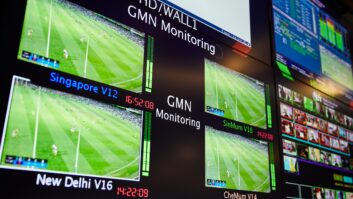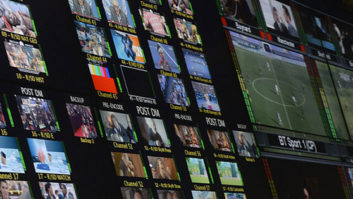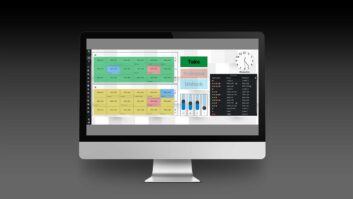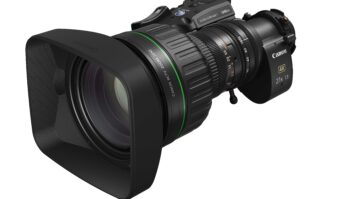NAB News: Director James Cameron has declared that the future of 3D is broadcasting and is joining with 3D innovator Vince Pace to target the TV market. The pair are working with Arri to develop a new version of the Alexa camera specifically for 3D, writes Adrian Pennington.
Cameron believes that within two years most 2D productions will have a 3D feed extracted from it for broadcast.
The two 3D pioneers are formalizing their relationship in new technology and services company, the Cameron – Pace Group (CPG), to accelerate worldwide adoption of stereo 3D acquisition. Arri is being lined up to partner with the new group in Europe.
Keynoting the opening of NAB, the duo described their vision for integrating 3D into 2D productions of all stripes from live sports and music events to episodic TV.
“The goal is to match the 2D model,” said Cameron. “There are a lot of myths about barriers to entry into the world of 3D and how much it costs and that you need a whole separate crew and that the technology is difficult. Our goal begins from establishing a business model for 3D TV. Our goal is to empower producers to let 2D operators and 2D production teams go about their business by integrating 3D into the 2D show, so that the 2D becomes a derivative product.”
One example of this is the use of Pace’s Shadow system during the recent US Masters. The Shadow is an additional lens that piggybacks on a standard 2D position and automatically pulls convergence or adjusts the frame for a 3D feed without the need for a convergence operator or separate 3D mobile unit. Of the 18 cameras that covered the US Masters in 2D, 10 were shared, with the 3D feed taken by ESPN and BSkyB.
“Let camera operators operate the cameras as normal for live sports and let the producers and craft personnel of episodic TV carry on doing what they are doing and let the facility and technology providers to create the solutions necessary,” added Pace.
“We have a transformative vision for where this is going,” said Cameron. “Our plans are to create the tools, methodology and services to make 3D ubiquitous over the next 5-10 years. By ten years I think 3D will be ubiquitous over all platforms. When Avatar 2 comes out I’d like to think that 3D is not even mentioned in connection with it. Over the next 3-5 years I think we’ll see 100% adoption at cinema level and rapid expansion into the home market, which will sweep along the broadcast industry.
“What we need to do to grow the market to the home is enable producers to do what they do already but to also do it in 3D in order to close the content gap.”
The company, said Cameron, is rapidly expanding: “We are investing aggressively in R&D and we’re not going to map out our plans now but we can say we want to make the camera and rig systems smaller, lighter, of higher quality and smarter in the sense they are auto-aligning so we can eliminate extra crew from the 3D model. We’re also going to go aggressive on stereo 3D training.”
He predicted that the number of 3D rigs on the market would balloon from 100 today to thousands as producers began to work on 3D broadcast productions as a matter of course.
“We are shifting from a paradigm of having created a few rigs to service the movie industry to one where two years from now the broadcast industry will be served with thousands of rigs,” he said.
“I would caution stereographers and those who define their expertise as 3D as making 3D niche. The signal which that sends out is that 3D is a problem and that I as a producer or creative can’t do my job unless I talk to someone like you. Really, 3D experts should be saying that ‘I know that you know what you are doing and it is my job to help facilitate that’. If you want to use a long lens, or move the camera here or have a certain shooting schedule then 3D should be no barrier.
“We are trying to craft deals and collaborations as we move into other markets whether that’s by sale or lease or strategic alliance,” added Cameron. “We met with Arri in Europe and think the Alexa will service the film side as well as TV and we see them as a good partner. By working together with partners we want to help take the chaos out of 3D technology production. We hope that our brand will provide some stability to producers and broadcasters trying to get to grips with this new format.”
Pace and Cameron suggested that content shot in native 3D should be branded as such so that audiences were aware that shows converted from 2D on the fly were of a lesser quality.
He also predicted that when high quality, large autostereoscopic screens come to market the curve of adoption for 3DTV sets would go ballistic.
“I would caution anyone in the broadcast industry about not being ready when that happens, about not having the content already starting to flow into pipelines,” said Cameron.
“Everything we predicted about 3D has come true and for the most part ahead of schedule,” added Pace. “Twelve years ago [when Pace devised the Fusion rig for Cameron’s 3D shoot of The Abyss] we assumed that this was going to happen and put resources and investment against it. The future of 3D is broadcast.”
Arri and Cameron – Pace build new Alexa
Arri is developing a new version of the Alexa camera with CPG. The Alexa M will divorce the body of the camera from the head, making it ideal for 3D work.
Arri confirmed that it had been collaborating for some time with CPG on the project and that CPG would take delivery of the first units this Autumn. The final production model would be ready to roll early 2012.
The Alexa M, which stands for modular, features the same sensor as in the Alexa and Alexa Plus, includes a PL mount and fibre optics that could tether the two parts of the camera over a mile in length.
Milan Krsljanin, Arri’s director of group business development said: “What Cameron and Pace wanted above all was an Alexa that they could operate with on a Steadicam and this is what we are enabling. There are still many things we need to work on for the Alexa M including lens control, how to get the signal back to the camera, how to pull convergence, where we keep the record mechanism, whether we use fixed or zoom lenses.”
Pace rigs with Alexas are have been used to shoot Hugo Cabret, 47 Ronin, The Life of Pi and The Three Musketeers.
The alliance with Arri is the first of a number of strategic alliances expected to be formed by CPG as it looks to establish itself as a greater force in 3D features and TV production.
www.cameronpace.com
www.arri.com
James Cameron photograph courtesy: Angela George






